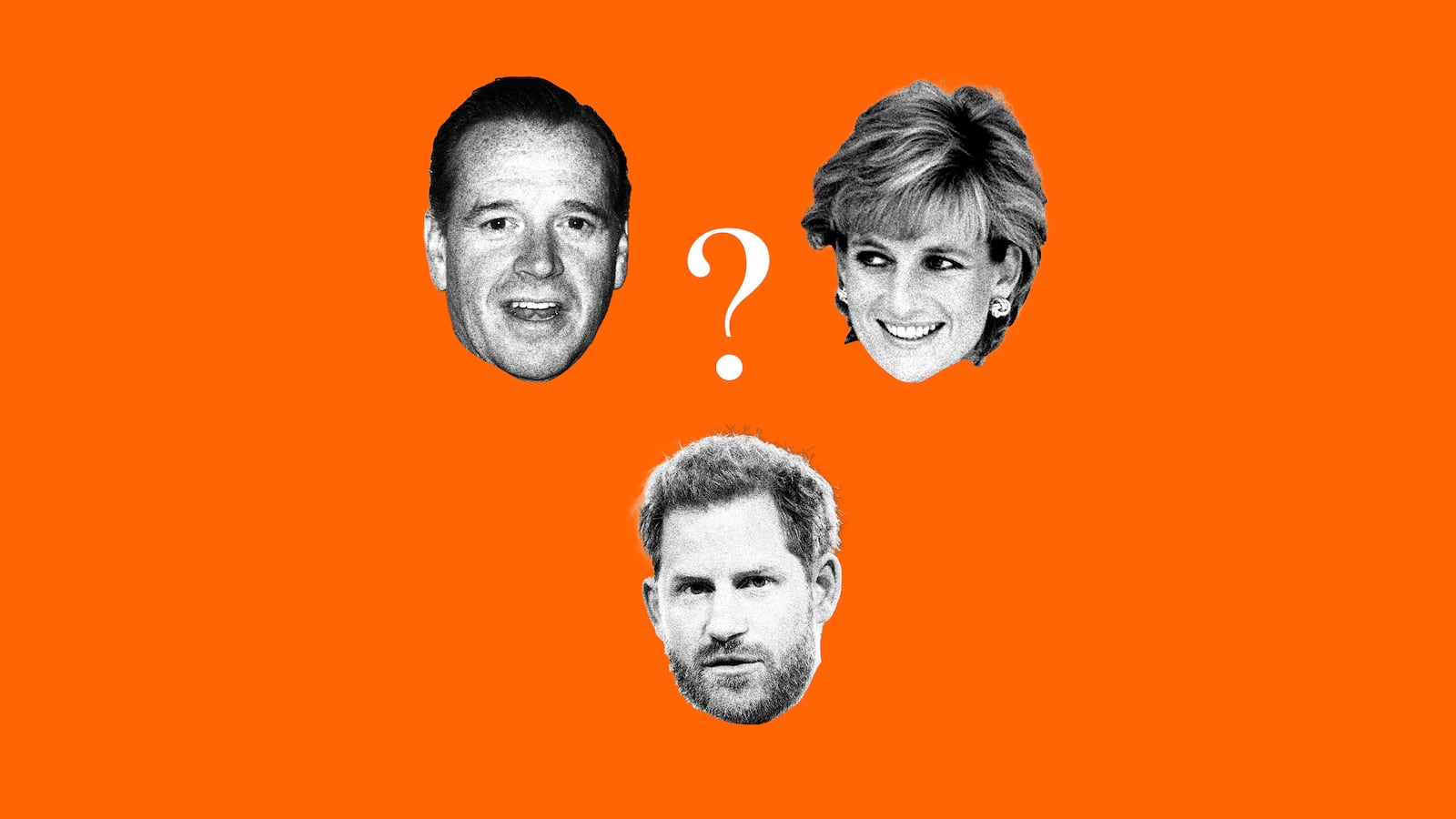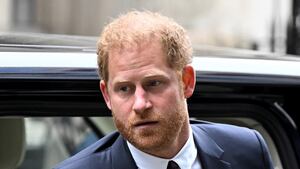Royalist is The Daily Beast’s newsletter for all things royal and Royal Family. Subscribe here to get it in your inbox every Sunday.
In the late ’90s and early 2000s an unfounded rumor set tongues wagging the length and breadth of British society. The explosive gossip alleged that Prince Harry’s father was actually James Hewitt, a dashing, red-haired guardsman whom Princess Diana had admitted to having an affair with him in her Panorama interview with Martin Bashir.
The tide of gossip ebbed and flowed in the years that followed, with speculation spurred on by the astonishing resemblance that Harry bore to Hewitt (and still does to this day). Also critical in the minds of those who wanted to believe the tittle-tattle was the fact that, as Diana’s lover for several years, from 1986 until 1991, Hewitt became close to the young Harry and his brother William, even going so far as to teach them polo and have replicas of his Household Cavalry Guards uniform made for each of the boys.
Such was the interest in the story that there were even wild rumors that Fleet Street’s red top tabloids had run covert missions to obtain samples of Harry and Hewitt’s DNA, and it was owing to this sub-rumor that the James Hewitt paternity story found itself back in the headlines this week, after Harry tackled the issue in court as part of his action against Mirror Group Newspapers (MGN).
Harry is suing MGN, alleging that their newspapers published stories on him using information obtained by illegal means, including voicemail hacking. One of the stories he cited was an article published in 2002 in the Sunday People headlined: “Plot to rob the DNA of Harry.”
Harry said the article “reported a plot to steal a sample of my DNA to test my parentage.”
In his statement Harry said: “Numerous newspapers had reported a rumor that my biological father was James Hewitt, a man my mother had a relationship with after I was born. At the time of this article and others similar to it, I wasn’t actually aware that my mother hadn’t met Major Hewitt until after I was born. This timeline is something I only learnt of in around 2014, although I now understand this was common knowledge amongst the defendant’s journalists.
“At the time, when I was 18 years old and had lost my mother just six years earlier, stories such as this felt very damaging and very real to me. They were hurtful, mean and cruel. I was always left questioning the motives behind the stories. Were the newspapers keen to put doubt into the minds of the public so I might be ousted from the royal family?”

James Hewitt, former lover of Diana, Princess of Wales emerges from a discount shopping warehouse in Exeter, Devon December 6, 1995.
ReutersHarry also mentioned this episode in his memoir, Spare, writing of the Hewitt paternity rumors: “There was even talk that some reporters were seeking my DNA to prove it—my first intimation that, after tormenting my mother and sending her into hiding, they would soon be coming for me.”
James Hewitt now lives a quiet life in a small town in the West of England, where it is understood he spends his days caring for his elderly mother. He is understood to be in rather poor health himself.
Although he co-operated with writer Anna Pasternak on a tell-all book entitled Princess in Love about his relationship with Diana in the ’90s, for which he was widely condemned as a “cad” by the British media, he has not spoken to reporters in years and The Daily Beast was not able to find a working phone number or verifiable email address for him and attempts to reach him via third parties were unsuccessful. One third party said there was “absolutely no way” he would speak.
However, he has always refuted claims he is Harry’s father; most recently, in 2017 he gave an interview to an Australian news channel in which he flat-out denied he was Harry’s dad.
The media have, as Harry’s comments in court this week made clear, largely accepted that he is not Harry’s father, largely on the basis of what Hewitt told Pasternak and others: that they only met in 1986 (Harry was born in 1984).
Pasternak told The Daily Beast: “It’s the boomerang story that just will not go away. But as the author of Princess in Love, which was the definitive account of Diana and James, I can firmly say that at no point did either of them hint at the merest thought of it. They met after he was born.”
Like others, Pasternak attributes Harry’s physical similarity to the Spencers’ coincidental physical resemblance to Hewitt.
Asked why she thought Harry would have mentioned the Hewitt rumors in his court case, she said: “I think Harry bringing up that article in court shows these constant, scurrilous rumors are a nagging source of pain for him. It’s another source of torment. The fact that he is saying he was worried it might lead to him being ousted from the family shows that it clearly fed into Harry’s sense of un-belonging within the family, the feeling that he was a spare, that as long as William was there he did not matter, and that even the one thing that should have been rock solid—his birth right—was questionable.”
One former news executive at the Sun in the noughties told The Daily Beast: “The dates didn’t match up so it was never taken seriously when I was there. It was a joke based on the fact they were both ginger. I remember once we got a false tip that William had bought Kate an engagement ring, and virtually the whole staff was put on it and spent three days trying to stand it up. There was never anything like that for Hewitt, which there would have been if people at the paper took the rumor seriously.”

Britain's Prince Harry, Duke of Sussex, departs the Rolls Building of the High Court in London, Britain June 7, 2023.
REUTERS/Toby MelvilleThe society author Lady Colin Campbell, who knew Diana and worked with her on a subsequently shelved co-writing project before producing a series of bestselling biographies of her, told The Daily Beast a similar thing. She said: “I knew James, and James himself confirmed to me that he didn’t meet Diana until 1986 at a drinks party thrown by [Diana’s lady-in-waiting] Hazel West, as I wrote in my book Diana in Private. The affair started long after Harry was born, and Harry always knew full well James Hewitt was not his father.
“In his book, Spare, he describes Charles joking to him about not being his dad. Charles would not joke about something that was true. Harry knows it’s not true and I doubt very much he only discovered in 2014, when he was 30, the date of his mother meeting James as he claimed in court.”
So why does the story continue to exert such a strong pull on the global imagination? Campbell has her theories: “Doubtful paternity is intriguing, and it is amazing how much he looks like him. But Harry also looks like his aunt Sarah McCorquodale and his uncle Charles Spencer. The real coincidence is that James Hewitt looks like Diana’s sister.”
One person who has spoken to Hewitt in recent years is the playwright Jon Conway, who authored a play in 2015 entitled Truth, Lies, Diana, in which Conway made the astonishing claim that Hewitt said he did in fact meet Diana before Harry’s birth.
The play recreates a conversation Conway says he had with Hewitt, in which Hewitt says, “Diana and I started our relationship more than a year before Harry was born. Now that doesn’t prove that I am his father. It’s just the inconvenient truth.”
Conway told The Daily Beast: “The fact is he told me that he met Diana a year before Harry was born. He agreed to say that he didn’t meet Diana until after Harry was born for obvious reasons. He said to me once he would rather let sleeping dogs lie.
“The fact that he met her a year before Harry was born does not mean to say he is Harry’s father, it’s just that the truth is messier than the official narrative put forward. James Hewitt saw more of Harry and William than their father did. He had a very close and loving relationship with them. Those two kids saw him every other weekend and in the school holidays for years.”







